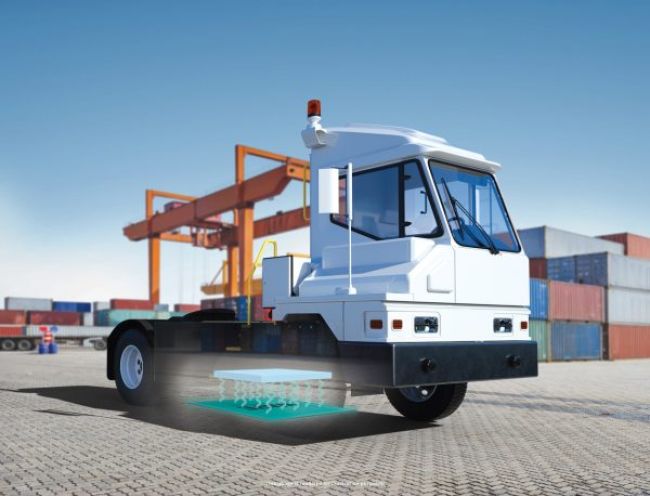
The State of EV Wireless Charging
As utilities adopt electric vehicles for their fleets, they face a fundamental question: wired or wireless charging? The decision could have long-term effects on the success of EV adoption. Electric utilities will be consulting with their customers on the same question.
While EV plug-in charging stations are familiar sights thanks to Tesla, wireless charging is less well known. But it’s getting ready for its time in the spotlight.
Wireless charging simplifies EV operations. Just park over a charging pad and then drive on – no plugging or unplugging is required. Wireless or inductive charging uses a charging pad embedded in the pavement to create a magnetic field to a receiving charging plate installed on the underside of the vehicle.
Since 2019, Antelope Valley Transit Authority (AVTA) in Southern California has used a wireless inductive charging system from WAVE (https://waveipt.com) for its battery-electric fleet, the largest in the U.S. Transit lines are an ideal situation for wireless charging; the lines have predictable routes and stopping points, so the buses can be recharged throughout their duty cycle. AVTA buses charge about 10 to 15 minutes per stop on their daily 290 miles.
Rethinking Duty Cycles
Pilot projects like the AVTA example have led to insights that will help utilities understand the strategy and benefits behind wireless charging.
Planning a wireless charging network requires thinking about where the vehicles may stop during their duty cycle. If the vehicles can charge incrementally during the shift, they don’t have to be taken out of service to recharge, and they can carry smaller batteries to cover the required range.
“You can change the mentality of how to use wireless versus other kinds of charging where it becomes part of the duty cycle and is almost like a perpetual operation,” said Aaron Gillmore, CEO of WAVE.
In a test of wired and wireless charging in a 200-truck parcel delivery fleet, charging provider WiTricity (https://witricity.com) found that wireless charging could save up to 50% on the total cost of operations. Much of the difference was due to “opportunity charging,” where the vehicles were charged while stopped for operational reasons. Spreading out the charging demand flattened peak loads for significantly lower electric expenses.
Wireless chargers could be installed at substations or frequent work sites. A vehicle can recharge while parked, eliminating the need to plug in. Even if a vehicle stops on a charger for 10 minutes, wireless charging works automatically, so the full 10 minutes is spent charging. The operator doesn’t have to get out of the vehicle, plug in a charging cable or perhaps use an RFID card to authorize the charge.
The utility fleet could plan charging hubs or nodes throughout the service area where vehicles could stop for a quick charge and then keep running throughout the duty cycle. Fleet managers will know how many miles a truck will operate and where it’s likely to travel, so a truck could be routed over wireless charging pads. One option is a charging island, like a fueling island, where vehicles get serviced and charge simultaneously.
“The concept is that you can get quick charges throughout the day on a high-powered charger and are always able to operate,” Gillmore said. “It opens the door to thinking about the economics of it differently.”
Planning for a Plugless Future
Wireless charging simplifies the charging network because there doesn’t have to be a charging dispenser for every vehicle. Even for electric utilities, supplying large amounts of power to their depots can be an expensive and time-consuming infrastructure project. Electric utility customers electrifying their fleets will face similar issues.
“You end up with fewer chargers serving many more trucks every day,” Gillmore said.
Wireless charging could help manage battery life. EV batteries like to operate in the middle of the charging range; charging to 100% frequently can degrade the battery life just as much as letting the charge drop to near zero. Wireless charging is built on the concept of incremental charging to keep the battery level relatively flat or charge neutral. The vehicle can recharge the energy consumed since the previous charge in a brief stop.
Wireless charging reduces charging infrastructure requirements and can improve efficiency and safety as operators don’t have to leave the truck to plug anything in. WiTricity estimated operators spend 12 to 15 minutes per day using plug-in charging systems. Because the wireless system uses magnetism rather than electric current, there’s no chance of shocks or short circuits. The magnetic field utilized for power transfer is not affected by water, snow, mud or other environmental factors.
Which Comes First?
As light-duty electric trucks come to market from Ford, Rivian and others, medium-duty trucks are under development by several manufacturers. Specialized vehicles may take more time to come to market. Due to the complexity of utility vehicles with chassis configured for upfitting, it takes another level of engineering to integrate battery packs along with buckets and outriggers.
Wireless charging could influence EV designs of the future. If vehicles can be charged during their daily duty cycles by wireless chargers in commonly traveled locations, their batteries can be smaller. In comparison, a truck charged by wire at the utility depot must carry a battery with enough capacity for the shift. A smaller battery design means less weight for longer range and a lower acquisition cost.
To some extent, it’s a chicken-and-egg scenario. Gillmore noted that wireless charging for fleet vehicles would be widely available when more fleet EVs are capable of using it.
About the Author: Gary L. Wollenhaupt is a Phoenix-based freelance writer who covers the transportation, energy and technology sectors for a variety of publications and companies.

